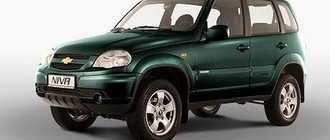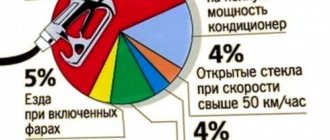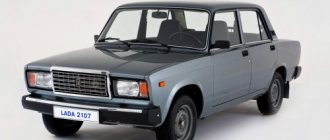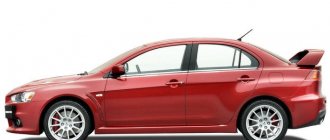Practical recommendations for optimizing fuel consumption in a VAZ 2106 car
In the early 70s of the last century, the VAZ 2106 met all the requirements of the technical regulations for middle-class cars in terms of parameters such as specific power and fuel consumption.
Today, although power units are obsolete, they continue to operate on a huge number of cars that are still in use in our country and abroad. The recent unsatisfying price of liquid automobile fuel forces owners to either switch to gas or look for ways to reduce fuel consumption.
Don't carry a roof rack in vain
Rationale : if you always have a roof rack on your roof, then fuel consumption increases by 10-15%, the same can be said about excess cargo in the trunk. If you carry two jacks, two sets of keys, and always a spare canister with 20 liters of gasoline, a spare generator, an ignition coil, etc., then fuel consumption will increase by 20%.
Disadvantages : once again you will have to install and dismantle the trunk. You need to find a place to store it.
Main factors influencing increased fuel consumption
The amount of fuel burned by a car is influenced by many reasons, both independent of the driver and predetermined by his attitude towards his car and the nature of his driving. Let's consider the main reasons causing increased fuel consumption of the VAZ 2106.
Season. It's no secret that in the cold season a considerable amount of fuel is spent on warming up the engine before a trip, as well as during stops and parking. When traveling in winter, the vehicle's heating systems must be turned on at all times, as well as headlights turned on during the daytime in some countries. This increases the load on the generator and, accordingly, on the power unit. Therefore, the fuel consumption of the VAZ 2106 in winter increases significantly. In summer, additional fans are also required to blow the engine radiator and ventilate the cabin.
Car load level. Everything is clear here: the more the car is loaded, the more work needs to be done to move the additional mass. From the physics course we know that all work requires energy. This results in additional waste of fuel. Sometimes you can reduce the fuel consumption of a VAZ 2106 by even emptying the trunk of your car of unnecessary things.
Driving style and road conditions. Prolonged driving in low gears increases gas mileage. This is also affected by sudden acceleration and immediate braking, as well as aggressive driving. And if the driver can influence these factors in the most direct way, then it is impossible to influence the condition of roads. We can only recommend choosing a route based on considerations of the quality of the road surface and traffic safety.
Aerodynamic resistance. It should not be forgotten that even large external rear-view mirrors can increase the fuel consumption of VAZ 2106 cars by up to 0.5 liters per 100 km of vehicle mileage, not to mention a roof rack filled with bulky items.
Condition of automotive systems and assemblies. This is the most important factor influencing the VAZ 2106, whose high fuel consumption worries the owner. After all, it is not news that a properly configured and adjusted engine, as well as serviceable components and assemblies of the car, will allow it to meet the consumption standards established by the factory. It must be recalled that for the VAZ 2106, fuel consumption is 7.4 liters per 100 km when driving along the highway at a speed of 90 km/h.
LADA Granta
Lada Granta is a domestic front-wheel drive car, developed on the basis of LADA Kalina. The developers were given the goal of making a car that would be as close as possible to the Kalina in technical parameters and appearance, but to reduce its cost. The desire to reduce the cost undoubtedly affected the appearance of the car.
LADA Granta sedan differs from Kalina in how the car looks from the front. The front part features a stylish “pattern” of headlights, radiator grilles, license plate and logo sign. These elements are placed on a black backing in the shape of the letter X. From the side and rear, Granta repeats the LADA Kalina sedan.
Granta's trademark is the black X in the front of the car - it houses slanted headlights, a large brand logo and chrome “boomerangs” that visually unite the radiator and lower grilles
In 2014, production of Lada Granta Liftback began. Like the sedan, the liftback has an X-shaped design at the front. In addition, the model is distinguished by a convex roof, smoothly turning into a miniature rear part.
At the rear of the liftback are small horizontally elongated lights, a large fifth door and a bumper with a black insert stylized as a diffuser.
LADA Granta sport (2018 to this day) is a front-wheel drive sedan of the “subcompact” category. It is not particularly spacious, nor is the liftback. During its development, the emphasis was placed on modern dynamic design, aimed at a youth audience. A voluminous bumper, a wing on the trunk lid and massive 16-inch wheels with a large number of small spokes give it a sporty look.
LADA Granta sport (2018 to this day) - front-wheel drive sedan of the “subcompact” category
Ways to reduce fuel consumption on the VAZ 2106
The very first thing is to reduce the amplitude and frequency when pressing the accelerator pedal. With each press, the carburetor accelerator pump injects about 1 ml of gasoline into the secondary chamber. You should adhere to a smooth ride, with a smooth start from a standstill and leisurely acceleration. It is also necessary to brake gently, assessing and predicting the road situation in advance and slowing down long before the car stops.
It is necessary to strictly follow the manufacturer's requirements regarding the degree of load of the car and not allow it to be overloaded. When planning your trip, decide whether you need a roof rack and remove it if you don't need it.
If fuel consumption has increased, pay close attention to the following factors regarding the condition and adjustments of the engine:
- set the ignition timing correctly (an incorrect ignition timing can cause overconsumption of up to 15%);
- change the air filter in a timely manner (with a clogged filter, the engine will run on a rich mixture);
- use good oils with minimal viscosity characteristics from trusted manufacturers;
- change the oil and oil filter promptly;
- The carburetor has a huge impact on fuel consumption, so adjust it (adjust the fuel level in the float chamber, eliminate the overflow of the accelerator pump, set the opening moment of the secondary chamber flap);
- adjust the ignition distributor according to the tachometer (ignition timing when increasing engine speed must meet factory requirements);
- adjust the clearances in the valve mechanism;
- measure the compression in the engine cylinders and repair it if necessary.
If you correctly adjust the VAZ 2106 engine, fuel consumption should decrease and meet the norm. Additionally, check the wheel alignment angles, tire condition and tire pressure. Love your car, maintain it on time, and drive calmly. Surprise yourself and your friends with low fuel consumption when traveling in this popular car.
Check your tire pressure regularly
Rationale : the lower the pressure, the higher the fuel consumption. At low pressure, the contact area with the road is larger and rolling friction is stronger. If you drive on wheels inflated to 1 atmosphere instead of 2, then you lose an extra 2-3 liters per tank. The advice is good for imported tires, as they hold pressure well, but our domestic Kama needs to be checked weekly.
In case of strong pumping, fuel consumption is noticeably lower, but all the bumps become noticeable, and the ride becomes uncomfortable. And if the pressure reaches 3 atmospheres, then the area of contact with the ground is so small that the braking distance increases quite sharply, which is dangerous. It is even more dangerous to overinflate wheels in winter, when a large area of tire adhesion to the road surface is especially important.
The acceptable pressure range is 2.2 – 2.4 atm.
In addition, you need to regularly monitor the condition of the tire treads. Heavily worn tires increase fuel consumption, including due to lateral deviation from a straight line.
Disadvantages : none
VAZ 2106 1.3 MT 64hp
Fuel consumption rate per 100 km
The model with this installation went all the way from the very start in 1976 to its removal from the assembly line in 1993. It is worth noting that for that Soviet period, the “six” was the embodiment of fashion. Especially considering the lack of imported competitors. The model consumes only gasoline and works exclusively with a 4-speed manual transmission. At the same time, the consumption cannot be called minimal. In the city, the VAZ consumes 9.5 liters, and on the highway - 7.6 liters. The maximum speed is only 145 km per hour. Naturally, acceleration to hundreds is corresponding - 18 seconds.
Real gas consumption
- Anton, Kirov. I got a 1992 1.3 liter device. Of course, there were few original spare parts in this “six”, but the engine did not let down. If you don’t tear it along the highway and warm it up every time in the winter, then it will serve faithfully for decades. By the way, consumption in this case will not be brutal either - up to 10 liters in the city and about 7 on the highway.
- Nikolai, Adler. For a long time there was a VAZ 2106 '85. And even though one and a half liters is more modern, 1.3 also shows good data. I drove this car, and I can tell you its fuel consumption down to hundredths. On average, in a free city I spent about 8.5 liters.
- Sergey, Ulyanovsk. The ’88 “Six” came to me in 2005 and served for another 5 years before being sold. I didn't particularly complain about the consumption. True, sometimes I had to drive with a stove even in the summer so that the engine would not get hot in traffic jams. So she takes her 10 AI 92.
- Mikhail, Tomsk. A very warm car. And it doesn’t matter how much volume is under the hood. Personally, I had a 1.3 liter 1994 model. The interior was completely warmed up in winter in just 9 minutes. But consumption in cold weather is about 9.5-10 liters.
- Oleg, Nizhnekamsk. I bought a new 1.3 MT in 2001. I drove it for almost 6 years and never complained about the engine. But he treated her like a family member. I changed the consumables myself, and sometimes even ahead of schedule. Well, the appetite of the “six” is not the smallest. I rarely left the city, so I filled it with 10 liters. per hundred.
Moskvich-402 / -407
The first Soviet passenger car of the Thaw period, which was completely created by Soviet engineers. Production of this model began in 1956. In just two years, 87,658 copies were produced.
Compared to its predecessor, Moskvich-402 had a more modern exterior and a more advanced body design. The car received a separate trunk with external access, curved windshield and rear windows, a high level of interior finishing, independent kingless front suspension with double wishbones and 12-volt electrical equipment, as well as many other innovations. It was equipped with an M-407 engine, which worked in conjunction with a manual 3- and 4-speed gearbox.
The first modification of the car occurred in 1958. The modified car was named “Moskvich-407” and had an improved 45 hp engine. The half-millionth MZMA car that rolled off the assembly line in December 1960 was the Moskvich-407. For several years in a row, half of all Moskvich-407s were exported, incl. to France, Belgium, Scandinavia, Finland, England and other countries.
In 1962, the transitional model “Moskvich-403” was released, which had a different sub-engine frame and engine compartment configuration. This model also used new units that were developed for the new Moskvich-408.
Based on the “407th” model, the all-wheel drive sedan “Moskvich-410 (410N)” and the all-wheel drive station wagon “Moskvich-411” were produced. These Soviet off-road vehicles were targeted at the needs of rural residents. The cars were equipped with larger tires of 6.4-15 inches with a “toothed” tread pattern, and the ground clearance was increased to 220 mm.
VAZ 2106 1.6 MT 75hp
Since 1976, the car in this configuration has traveled across the vast expanses of the Union, and then the CIS. This unit is the most powerful carburetor unit in the entire line. In terms of bodywork, this version is completely no different from other versions. The motor has a larger volume and, accordingly, better performance. Production of this type stopped in 2006. In terms of consumption, the unit is not much different from the version with a volume of 1.3. In the city, 10.1 liters are consumed, and on the highway – 7.4 liters. The engine is powered by gasoline and works in tandem only with a manual gearbox. Maximum acceleration is up to 150 km per hour.
- Alexander, Alapaevsk. I recently bought myself a 2002 version 1.6 MT. I accelerated it to 160 km/h, so the official data lies a little. But in terms of consumption everything is accurate. In a mixed cycle, less than 10 liters does not come out. Usually I fill the tank with 20 and for 190-200 km it’s enough for me.
- Alexey, Ivanovo. I drove a 1.6 1996 for about 3 years. After that I made capital. By the way, consumption dropped slightly after the repair. Now sometimes it’s possible to get even beyond 8 liters per hundred. But this is only on a smooth highway.
- Evgeniy, Moscow. My “six” ate gasoline and oil in half. I really didn’t want to repair the engine, but apparently the time has come. If you don't take this cap into account. repair, the engine is not capricious and pulls well even when the car is full to capacity. On the highway, according to the passport, it took 7.5 liters.
- Sergey, Sarov. In the 90s this was my salvation. I took the 1991 model. and always repaired it myself. I didn’t even touch the engine, I only managed to change the oil and spark plugs. And he always thanked me for his precise work, drove the car, and lived on this money. I must say that the 1.6 engine did not rob me. I count 10 liters. per 100 km is a very small figure.
- Dmitry, Cheboksary. During the time I used (1990-1995) the “six” 1.6 I managed to change two boxes, 2 batteries and many other small things. But the engine withstood the service staunchly. In other words, this is the most reliable unit in the 2106. It didn’t tear on the highway, and it only consumed about 7 liters.
The VAZ 2106 as a car model has lived too long of a life. But these “workhorses” will roam the expanses of Eastern Europe for a long time to come. Although they are outdated, their simplicity and ease of repair allow them to compete with modern and technically advanced competitors.
AZLK-2141
“Moskvich” AZLK-2141 is a Soviet and Russian front-wheel drive passenger car with a hatchback body, produced from 1986 to 1998 at AZLK. A total of 716,831 copies of this model were produced.
AZLK-2141 has a layout with a longitudinal arrangement of the UZAM-331.10 and VAZ-216-70 power unit, which was paired with a 5-speed gearbox of the original design with primary and secondary shafts located at the same height. As a result, it was possible to reduce the overall height of the power unit and lower the hood line. Along with the base 1.5 and 1.6-liter engines, VAZ and UZAM engines with a volume of 1.7 and 1.8 liters were used.
Structurally and externally, the car looked like a real breakthrough compared to previous models: 5-speed gearbox, fourteen-inch wheels, relatively large wheelbase, wide hatchback body, MacPherson strut front suspension and dependent rear suspension with stabilizer and Panhard rod, rack and pinion steering and integrated “volumetric” plastic bumpers. The body itself was estimated to have a fairly decent aerodynamic coefficient Cx=0.35.
In 1997, the Moskvich-2141-02 Svyatogor modernization appeared with a more powerful Renault 2.0 liter engine and an updated appearance. Also in 1997, a small-scale M-2141R5 “Yuri Dolgoruky” with a hatchback body extended by 200 mm and a similarly extended sedan Moskvich-2142R5 “Prince Vladimir” appeared.
VAZ fuel consumption.
VAZ fuel consumption is always acceptable. The developers are seriously thinking about reducing fuel consumption for different VAZ brands.
VAZ cars are domestically produced cars. VAZ is a Volga automobile plant, it is located in the Samara region in the city of Tolyatti. VAZ cars are distinguished by moderate fuel consumption and affordable prices.
Data on VAZ fuel consumption are described below in the table on fuel consumption of VAZ cars. VAZ cars are not only a means of transportation, but also an integral part of everyday human life.
Fuel consumption of a VAZ depends on its modification (brand), driving style and time of year. The table below shows the average fuel consumption of the VAZ brands of the 2107, 2114, 2110, 2106, 2112, 2109, 2115 family.
UAZ-452
The legendary Soviet cargo-passenger all-wheel drive vehicle, produced at the Ulyanovsk Automobile Plant from 1965 to the present. For its external cubic appearance with rounded edges, the UAZ-452 was popularly nicknamed “loaf”, and in the cargo version - “tadpole”.
In addition to the basic “van” version, the UAZ-452 has a large number of different modifications, the main ones of which are: UAZ-452A - an ambulance that can travel off-road to the most remote places; UAZ-452V - nine-seater minibus; UAZ-452D is a truck with a double cab and a wooden body.
In 1985, the UAZ-452 and its modifications received new indices. So the all-wheel drive minibus began to be designated - UAZ-2206, and the ambulance - UAZ-3962. A special armored vehicle for transporting valuables was also created on the basis of the UAZ-452.
Table of fuel costs for VAZ brands.
The table describes the average costs for different VAZ brands . Fuel consumption is presented in three types - city, highway and mixed (average) fuel consumption. All data on fuel costs are from the VAZ car manufacturer. For almost all brands of VAZ cars, fuel consumption does not exceed 10 liters per 100 km, with the exception of the carburetor Niva.
Average fuel consumption VAZ
liter/100 km
120 km/h=10
120 km/h=9.8
| Brand VAZ | Power, hp | City | Route | |
| VAZ 2101 (1.2, carburetor) | – | 10.5 | 11 | |
| VAZ 2102, 2103 (1.5, Carburetor) | 71 | 11 | 11.5 | |
| 2106 (1.57 engine, carburetor, four-speed gearbox) | 76.4 | 9.5 | 10.5 | 8.5 |
| 2106 (1.45 engine, carburetor, four-speed gearbox) | 73.5 | 9.9 | 10.8 | 9.0 |
| 2106 (engine 1.6, injector) | – | 8.4 | 9.8 | 7 |
| 2105 (1.3, carburetor) | 64 | 9.1 | 10.2 | 8.1 |
| 2105 (1.5, carburetor, four-speed gearbox) | 71.1 | 8.8 | 9.5 | 8.0 |
| 2107 (1.6, injector) | – | 7.8-9.8 | 9-11.5 | 6.7-8.2 |
| 2107 (1.6, carburetor) | – | 8.9 | 10.2 | 7.5 |
| 2107 (1.5, carburetor) | – | 8.3 | 9.6 | 7.0 |
| 2108, 2109, 21099 (1.5, carburetor) | 72 | 9.1 | 10.1 | 8.2 |
| 21083, 21093, (1.5, injector) | 72 | 7.6 | 8.5 | 6.7 |
| 2110, 2111, 2112 (1.5, carburetor) | 67.7 | 9.5 | 10.5 | 8.4 |
| 2110, 2111, 21124 (1.5, injector) | 72 | 7.9 | 8.7 | 7.0 |
| 2113, 2114, 2115 (1.5, injector) | 72 | 7.6 | 8.5 | 6.7 |
| Lada Granta (8 valve) | 80 | 7.0 | 8.3 | 5.8 |
| Lada Granta (8 valve) | 90 | 7.7 | 9.3 | 6.1 |
| Lada Granta (16 valve) | 98, 106, 120 | 8.1-10.1 | 9.2-11.2 | 7-9 |
| Lada Kalina 21117, 21118, 21119 (1.4 engine) | – | 6.9 | 7.8 | 6.0 |
| Lada Kalina 21118, 21119 (engine 1.6) | – | 7.2 | 8.1 | 6.3 |
| Lada Priora (1.6) | 90 | 7.6 | 8.8 | 6.5 |
| Lada Priora (1.6, 16 valve) | 106 | 8.6 | 9.5 | 7.7 |
| Lada Vesta 21179 (1.8, 16 valve) | 123 | 8.5-10.5 | 9.5-11.5 | 7.5-9.5 |
| Lada Vesta 21129 (1.6, 16 valve) | 106 | 8-10 | 9.0-11.0 | 7.0-9.0 |
| Lada x-Ray (X-ray, 1.6, 16 valves) | 110 | 7.9 | 8.8 | 7.0 |
| Lada x-Ray (X-ray, 1.8, 16 valves) | 122 | 8.1 | 9.1 | 7.2 |
| Lada Largus (1.6, 8 valve) | 90 | 8.6 | 9.5 | 7.7 |
| Lada Largus (1.6, 16 valve) | 105 | 8.2 | 9.0 | 7.5 |
| VAZ 21213 (Niva, 1.7, carburetor) | – | 11.5 | 13.0 | 10.0 |
| VAZ 21214 (Niva, 1.7, injector) | – | 9.8 | 11.0 | 8.5 |
| VAZ 2131 (Niva, 1.8, injector) | – | 11.1 | 12.8 | 9.5 |
VAZ has acceptable fuel consumption!
The car is given good dynamics and acceptable fuel consumption thanks to its reliable engine. VAZ has an affordable price for both a new and an old car. Old VAZ brands are acceptable to most people. The new VAZ engine demonstrates extreme efficiency, thanks to which the car has low fuel consumption and a reduced level of harmful emissions into the atmosphere.
VAZ - average quality cars, affordable price and acceptable fuel consumption.
What could cause increased consumption at VAZ?
1. Increased VAZ fuel consumption is observed in cars with a worn out engine. High piston wear will increase fuel consumption of any VAZ brand. Wear is determined by measuring compression in the VAZ engine block. If the compression is low, the piston needs to be replaced (rings, piston, block boring).
2. The increased flow rate is influenced by the coolant temperature, throttle position, mass air flow and detonation sensors.
3. High fuel consumption in VAZ cars is observed when the accelerator drive is faulty, the wheel alignment is adjusted correctly, or tire pressure is reduced.
4. An increase in fuel consumption in VAZ cars with carburetor engines is observed when there is a problem with the carburetor. These are holes in the diaphragms, incorrect adjustment of the choke cable, enlarged fuel jets, mixing up of air jets in two working chambers (chamber 1 = 165 mm, chamber 2 = 125 mm).
Timely completion of technical inspection will allow VAZ to maintain fuel consumption at the level declared by the manufacturer.
see also
Comments 31
Eats 9-10l, on 4 mortar
From personal experience I will say this, on Solex it will be faster. What about the expense? As you press your slippers, so will you eat. And to reduce consumption, take a 5x5 wooden block and place it under the accelerator pedal. The thicker the bar, the lower the consumption. Gee
There is an option, walk)
Nope) Even though she eats a little too much, I won’t leave my car)
Solex will only increase consumption, just show the machine to a good specialist (usually older, experienced men) who have normal Soviet jets, repair kits, and so on, because there is nothing to take from new ones. Of course, they won’t reduce your consumption by half, but they will help significantly.
I went to the best carburetor in town. He said it definitely wouldn’t be less than 11, since the sixes from the factory had a consumption of 10.6 per hundred square meters without warming up.
Well then, yes, this is kind of a normal expense. There are simply examples with a consumption of 20, or even 25 and 30. Those who ask what to do and climb into the carb with their own hands.
wow, it’s scary to imagine such consumption on a Lada) Of course, many people advise using gas, but I am a supporter of the fact that gas still has a negative effect on the engine.
Perhaps the second generation has a detrimental effect on the engine, but the 4th does not (such a generation does not shine for VAZ). The main thing is to correctly adjust the OZ and everything will be fine. Because the burning speed of propane and gasoline is different. And even when warming up, the engine still runs on gasoline. Five minutes on gasoline is enough. And on the 4th generation, a tiny amount of gasoline is mixed into the gas. So don't be afraid of gas. If you travel a lot, of course.
Principles of fuel consumption for a VAZ 2106 car
In standard VAZ 2106 models, fuel consumption is carried out according to the classical scheme. The main part in the fuel supply system is the carburetor. The “six” can be considered one of the typical representatives of carburetor cars.
One of the indicators of stable operation of a machine is fuel consumption. Car enthusiasts note different indicators of this value, depending on the season, driving characteristics, and load on the car. But these are deviations within the normal range, acceptable and understandable. An increase in fuel consumption entails additional costs for maintaining the car. What are the reasons for the increase in fuel consumption by the VAZ “six” and whether they can be significantly reduced - these questions are pressing for owners of cars of this brand.
General tips for operating a car
To minimize the influence of minor factors and achieve real fuel savings, follow a number of simple rules:
- Fill with gasoline with an octane rating of at least 92 according to the manufacturer's recommendations. If you accidentally come across low-quality fuel, try to drain it from the tank and refuel with normal gasoline.
- Maintain the recommended tire pressure of 1.8-2 atm depending on the load. Air pressure must be checked at least once a week
- During the cold season, warm up the power unit before driving. The algorithm is as follows: start the engine, let it run for 2-5 minutes (depending on the air temperature), then start driving slowly in low gears.
- Do not delay repairing the chassis; follow the procedure for adjusting the camber angles of the front wheels.
- When installing wider tires, replace stamped wheels with alloy wheels. In this way, it will be possible to compensate for the increase in the weight of the wheels and improve the appearance of the “classics”. Installing alloy wheels instead of steel allows you to lighten the wheels by a good ten kilograms
- Do not weigh the car with unnecessary external elements that increase the aerodynamic drag of the environment. If you are a fan of styling, choose a beautiful and at the same time streamlined front body kit, dismantle the old bumper.
Unlike modern cars, where the filling pipe is equipped with a mesh, emptying the tank of the “six” is much easier. Insert the hose into the neck, lower it into the container and use suction to direct the fuel into the spare canister.
Air resistance has a significant impact on engine fuel consumption. If we compare the movement at 60 and 120 km/h, then the aerodynamic drag increases by 6 times, and the speed - only by 2 times. Therefore, the triangular side windows installed on the front doors of all Zhiguli cars add 2-3% to the consumption when open.
Find out whether it is possible to refuel a full car tank: https://bumper.guru/klassicheskie-modeli-vaz/poleznoe/pochemu-nelzya-zapravlyat-polnyy-bak-benzina.html
Video: how to save gasoline in simple ways
Fuel supply diagram
To find out the reasons for the excessive consumption of the fuel mixture, you should understand how the fuel supply system of the 2106 car is designed. The gas tank in the six is located in the luggage compartment, fixed and separated by a plastic partition. The tank is equipped with a neck for filling gasoline; it is brought out through the hatch of the rear right wing and sealed to prevent the penetration of dust and dirt particles into the tank.
To regulate the pressure of gasoline and air vapors, the gas tank is equipped with a plastic ventilation pipeline laid in a loop. The gasoline level indicator is fixed through a rubber gasket. This rheostat-type sensor is located on a flange, which is welded to the top of the tank. The sensor is a block element with a tube (fuel intake) with a mesh filter at the end. Changing the level of the fuel mixture causes the float-shaped sensor to start moving, changing the resistance of the rheostat. Because of this, the current that the sensor-pointer system passes through changes, and, accordingly, the pointer (arrow) moves.
The pipeline, consisting of special rubber in a fabric weave, is fastened and fixed to the fuel line. All holes for hoses or tubes are hermetically sealed with rubber bushings. To gently clean gasoline, a filter is placed in front of the pump. The power system cannot do without this filter, which retains mechanical particles and cleans the mixture to the required level. Other filters that contain the pump, gas tank or carburetor cannot cope with such tiny fragments. A mechanically driven fuel pump (diaphragm type) creates excess pressure and injects the fuel mixture into the carburetor.
Located to the left of the engine cylinder block, it also has a manual fuel pumping lever. The carburetor produces the desired composition of the air-fuel mixture and regulates its intake into the engine cylinders. The carburetor is controlled from the driver's seat using the accelerator pedal; it is connected to the drive lever of the first carburetor chamber by a system of rods and hinges.
Carburetors on VAZ models are of two types - “ozone” and “weber”.
Specifications
The following main characteristics of VAZ 2106 engines can be distinguished:
| OPTIONS | MEANING |
| Cylinder block material | cast iron |
| Supply system | carburetor/injector |
| Type | in-line |
| Number of cylinders | 4 |
| Valves per cylinder | 2 |
| Piston stroke | 80 mm |
| Cylinder diameter | 79 mm |
| Compression ratio, atmospheres | 8.5 |
| Volume, cm cube. | 1569 |
| Power, l. With. at 5400 rpm | 75 |
| Torque, Nm at 3000 rpm | 116 |
| Fuel | AI 92 |
| Fuel consumption per 100 km, l | |
| - city | 10.3 |
| – route | 7.4 |
| – mixed | 10 |
| Oil consumption per 1000 km, g | 700 |
| Overall dimensions (LxWxH), mm | 565x541x665 |
| Weight, kg | 121 |
| Types of oil | 5W-30, 5W-40, 10W-40, 15W-40 |
| Oil volume, l | 3.75 |
| When replacing, fill, l | 3.5 |
| Engine life, km | |
| 1. According to the factory | 125,000 |
| 2. Actually | 200,000 |
| Tuning (potential/without loss of resource), l/s | 200/80 |
| Candles | A17DVR, A17DV-10, FE65CPR |
| What cars can it be installed on? | VAZ 2106, 2103, 2121, 21053, 2107, VAZ 21074 |
The motor is installed on cars: VAZ 2106, 2103, 2121, 21053, 2107 and 21074.
From the technical characteristics it is clear that the presented motor design has been significantly improved and finalized by engineers.
The main reasons for the increase in fuel mixture consumption
When increasing gasoline consumption when driving, the VAZ owner needs to pay attention to the following points.
- Possible fuel leaks - check the fuel system, the fuel line under the car, the condition of the clamps, whether the gas tank is sealed.
- Clean the carburetor jets.
- Check (and if necessary, change) the filter element on the carburetor air filter.
- Monitor the correct idle speed control and adjust the mixture quality screw.
- Check the tank: the fuel level sensor (indicator) may be incorrectly adjusted or misaligned.
- The engine is running on choke due to a malfunction of the air damper.
- The cylinders of the piston group are worn out, which forces the car owner to use lower gears; which also entails overspending.
- The power of the VAZ 2106 engine is reduced due to incorrectly set ignition timing.
- The ignition distributor is broken (the vacuum regulator does not function).
- The engine overheats - there is a reduced filling of the cylinders with a mixture and a decrease in power. In case of poor warm-up, there is also excessive consumption of gasoline, which is not completely burned in the engine, and loss of power.
- Check the fuel pump, there is a possibility of a broken diaphragm.
The driver's driving style also causes increased gasoline costs: sharp and too frequent pressing of the brake pedal, constant driving in lower gears (for various reasons).
Economy driving skills
Drivers are taught proper driving techniques at a driving school. When operating the domestic “classic” VAZ 2106, you need to take into account a number of points:
- The first gear of the car is quite “short”. You shouldn’t rev the engine too hard; once you’ve started moving, go to second speed.
- Frequent sudden accelerations and stops are a real scourge for any car; along with excessive consumption of gasoline, the wear of parts and components accelerates. Move more calmly, try to stop as little as possible, use the inertia (rolling) of the car.
- On the highway, maintain cruising speed at all times. The optimal value for the “six” with a four-speed gearbox is 80 km/h, with a five-speed gearbox – 90 km/h.
- When coasting down a mountain, do not turn off the speed - brake the engine and watch the tachometer. When the needle drops below 1800 rpm, shift to neutral or low gear.
- In a city traffic jam, don’t turn off the engine in vain. If the idle time does not exceed 3-4 minutes, stopping and starting the engine will “eat up” more fuel than idling.
Moving along busy city streets, experienced drivers monitor the signals of distant traffic lights. If you can see a green light in the distance, there is nowhere to rush - by the time you get there, you will come under a red one. And vice versa, if you notice a red signal, it is better to speed up and drive under the green one. The described tactics allow the motorist to stop less at traffic lights and thus save fuel.
Against the backdrop of rising fuel prices, driving outdated cars becomes doubly expensive. The “six” needs to be constantly monitored and repaired on time, so as not to pay extra money for gasoline. Aggressive driving is not at all compatible with carburetor “classics”, where the power of the power unit does not exceed 80 hp. With.
Troubleshooting Gasoline Meter Problems
When driving a car on the highway, instrument indicators are the main thing the driver focuses on. Therefore, problems with the tank full indicator can lead to serious problems. To control the gasoline level, the tank has a fuel mixture level indicator. The gas tank of any VAZ car has a float indicator. It measures the voltage, and the indicator changes the value depending on the value of the fuel mixture.
When the gas tank is only five liters full, the light on the indicator turns on. If there is a malfunction or breakdown, the tank-indicator system does not work or fails. The initial stage of diagnosis consists of assessing the disorders.
| Violations | Manifestations |
| Typical breakdowns are unstable readings of the instrument needle. | A constant minimum or maximum, or a “floating” position is possible. |
| Pay attention to the indicator lamp. | It may blink, stay on all the time, or not light at all. |
| Simultaneous failure of the named devices. | Sometimes such phenomena are observed, although the reason lies in the sensor. |
To carry out diagnostics, remove the device and inspect it. If it is broken, you can replace it with a new one, or heat the broken area with a soldering iron. Sealant or epoxy will not help - gasoline corrodes these materials. Then they check the rheostat and the slider: if it is closed, then a new one is installed. Perhaps it is not pressed tightly, then it is shifted to the edge of the track, in this place the production of the rheostat is reduced.
To ensure that the device is working properly after these manipulations, check the resistance using an ohmmeter. If the indicators differ significantly from 345 Ohms, then you should simply replace the element with a new one.
Choose the right engine oil
Rationale : if you use oil with a reduced viscosity, then fuel consumption decreases as the resistance decreases. Oil viscosity depends on temperature, and it is the loss of viscosity that causes the engine to “seize”
Disadvantages : none
You can see additional recommendations by looking at another infographic:











